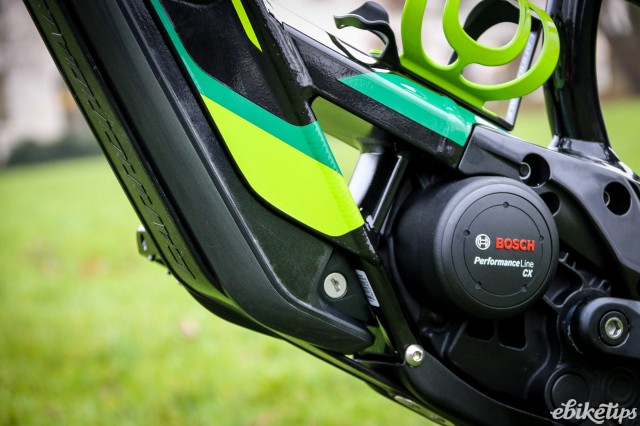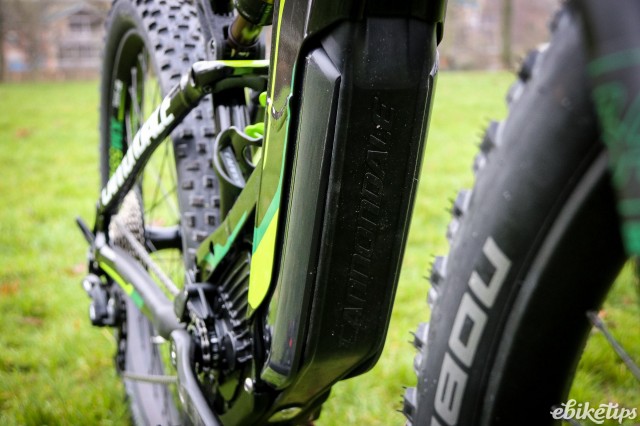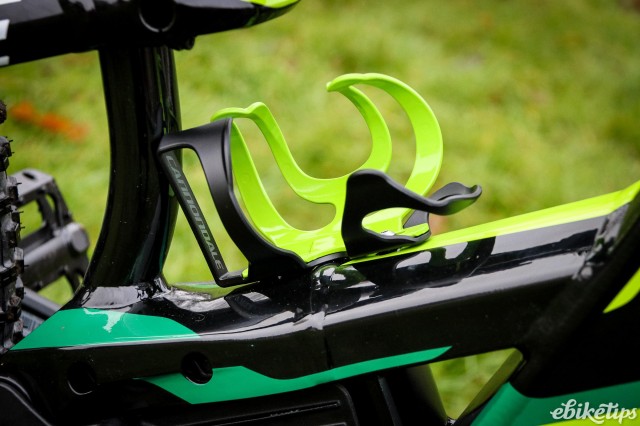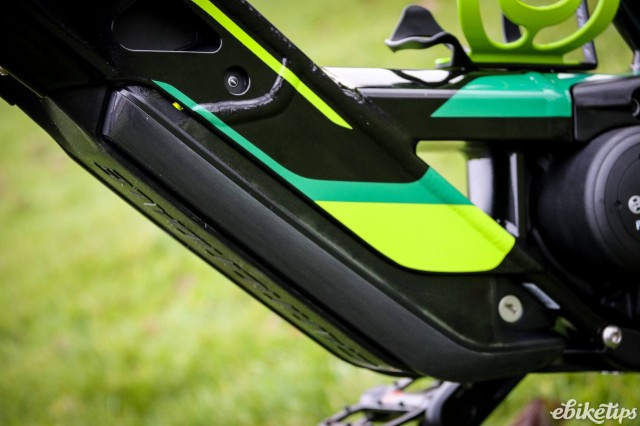Cannondale Moterra 1
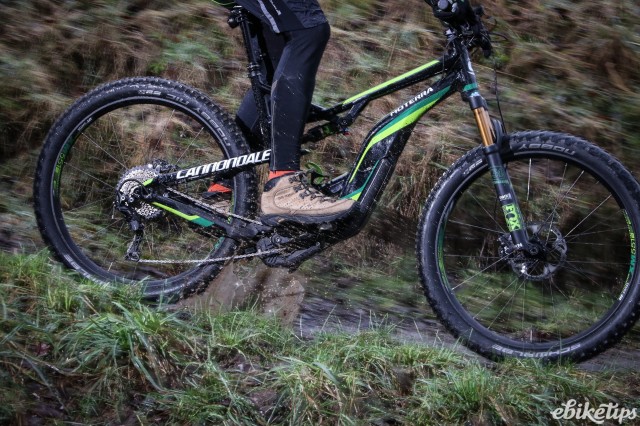
Overview
- Very assured and predictable handling
- Excellent suspension performance
- Great grip from the Schwalbe tyres
- Battery looks a bit vulnerable
- You'll need deep pockets
Cannondale's Moterra range uses an interesting and unique frame design to place the battery lower down for a better centre of gravity, a custom motor mount to keep the chainstays short, and a chainline that's moved away from the frame for better mud-shedding. The result is a bike with excellent and predictable handling that's a hoot to ride in all conditions. This plus-sized, 130mm travel incarnation is the one you want if you're riding a mix of trail centres and natural trails, and you have deep pockets; there's a 160mm long travel version that'll suit the more gravity-inclined, and cheaper builds if you can't stomach the £5k+ asking price. All three 130mm bikes share the same frame design, so you're getting the handling and all-weather benefits whichever you choose.
Cannondale's tag line for this range is "Mountain Biking – Supercharged". They've put a lot of thought into this bike, and it's most evident in the motor and battery configuration.
This bike uses a Bosch Performance Line CX motor, which is still the power unit you're most likely to see on the trails. Many e-MTBs bolt that on to the bottom of the frame and then the battery goes on the down tube. It's a simple enough job to lay the bike out like that but it does have its downsides. For a start, the weight of the battery is higher in the frame, meaning the overall centre of gravity of the bike is lifted making it a bit less stable. We've seen manufacturers addressing this: Lapierre's new Overvolt, for example, slides the battery down and across the top of the motor.
Cannondale's approach is different: they've located the battery not on top of, but underneath the down tube, and lowered it such that the bottom of the battery is on a level with the bottom of the motor. This, they claim, means that the Moterra has the lowest centre of gravity of any e-MTB. We don't have all e-MTBs to hand, nor a clever jig for working out centre of gravity, but it stands to reason that moving the 3kg of battery further down will make the centre of gravity lower.
The battery position means it's more susceptible to damage from trail debris; Cannondale have addressed that with a protective rubber strap (The Bat Strap) that covers the battery and also helps to reduce the vibration in the mounting system. The side and top plates of the battery enclosure create a box section which Cannondale call the Torsion Box, which they claim adds stiffness to the main triangle.
The design of the frame also means that it's the only full-suspension e-MTB that we know of to offer a full-sized bottle cage mount; our bike came fitted with Cannondale's own side-entry cage and you probably want a side-entry one as there's not masses of room, even on our XL bike.
Another common issue with the Bosch motor is that the standard configuration requires fairly long chainstays, especially in a full suspension bike where it's difficult to get the pivot where you'd want it. Cannondale have developed their own motor mount to tackle that. They've mounted the motor at an angle (a bit like the Orbea Wild) which allows them to tuck the suspension pivot in a bit further for a shorter rear end. The pivot position is unaffected by motor torque so there's no need for pulleys or linkages to compensate. The result is the shortest chainstays in class, according to Cannondale, and not significantly longer than their non-powered bikes.
Cannondale have also brought their Ai offset chainline to the Moterra, which moves the chainring and cassette out by 6mm, giving better performance and more mud clearance with the short chainstays. The Moterra 1 has a custom chain guide which sits on the main pivot.
This build of the Moterra is high-spec stuff, as you'd expect from a bike costing over five grand. The Fox Factory 34 Float fork is optimised for e-bikes, which means beefing up the stanchions to cope with the extra heft of the motor and battery. You get a matching Fox Factory Float EVOL rear shock bolted into the Moterra's carbon link plate.
Transmission is from Shimano and it's all XT, with the exception of the 11-speed SLX cassette. There's a KS LEV dropper seatpost with remote for on-the-fly seat height fiddling, and a Fabric Scoop Elite saddle on top of that. The Cannondale own-brand alloy cockpit includes a 780mm bar; Cannondale use the Bosch Intuvia display on this bike while the LT bikes will have the new Purion unit instead.
The Moterra 1 on test here is the top-spec build of Cannondale's 130mm all-mountain plaftorm, which starts with the £3,799 Moterra 3 and also includes the £4,299 Moterra 2. On top of that there's a 160mm long-travel bike available in two builds, the £4,499 Moterra LT2 and the £5,499 Moterra LT 1. So five bikes in total: Cannondale are clearly not just dipping a toe in the water here.
Dave says: If you primarily ride a mountain bike to have fun, then you need to try an e-MTB simply because they make it more fun. You can ride further, more easily, and the motor assistance means that climbing becomes almost as fun as descending. The payback for the added motor system is extra weight (6-7kg) and often a bike that doesn't handle quite as well as its non-powered siblings. Often, but not always: this Moterra really isn't compromised at all in the way it behaves on the trail. This bike is one of the funnest I've tried.
There's a lot going on here. The most obvious design innovation here is the way that the battery is mounted, and its position. Slinging the battery underneath the down tube makes the centre of gravity lower, and it really does seem to make a difference. It's impossible to isolate the effect of any one design decision on a bike's handling, but the Moterra feels incredibly well planted on the trails, and very stable. In common with other e-MTBs that I've tried, the extra sprung mass actually improves the suspension response a lot of the time, especially when you're not seated: there's more bike weight to act against the unsprung parts. It's most noticeable when you're unweighting the bike over rocks or roots: there's very little bouncing about and a lot of traction.
That traction is helped by the plus-sized tyres. This bike gets Schwalbe Nobby Nic 2.8” rubber and what you get is the ability to run them at low pressure for masses of traction. The natural trails around Bath can be a bit of a quagmire in the winter, and there's some sections that really aren't any fun at all. The addition of a motor and tons of grip changes all that: it takes a really significant amount of squishy mud to make a trail unrideable on this bike, meaning that summer-only trails can be ridden all year round. They have some downsides: On the all-weather trails at Bike Park Wales I ran them a bit firmer to stiffen up the sidewalls, as they can be a bit vague when you're turning the bike hard. The downside to that is a bit of a reduction in traction which can mean you ending up getting a bit sideways over greasy roots. As always, it's swings and roundabouts there. One thing that you won't have to worry about is pinch punctures as both the tyres and the DT Swiss wheels are tubeless ready and easy to set up.
The tyres make this 130mm bike feel like it's got a bit more give than that, but obviously the bounce from the tyres isn't damped like the excellent Fox Factory 34 FLOAT FIT4 fork and FOX Factory Float EVOL are. No complaints on the suspension: both fork and shock are really, really good and offer predictable and well-balanced travel front and rear. The 3-position lever on the shock and the lockout on the fork are more or less redundant: because you've got the motor assistance you're much less likely to have to stand up and give it the beans up the steep stuff. The only time I locked the bike out was when I had to tow a stricken rider (broken chain and rear mech) up a mile of road climb using a long stick I found in the woods. True story.
Anyway, the suspension is top quality, as you'd expect from bike above £5k, and the transmission is the same: full Shimano XT never gave us any issues at all during testing, and that was through some wet and deliberately very muddy rides. I've had Bosch-powered e-bikes that have suffered from the chain getting sucked around the chainring. I never had any problems with the Cannondale: how much of that is due to the Ai chainline, which moves the cog and cassette 6mm out, is hard to say, but it certainly doesn't seem to do any harm. You'll need to bear in mind that you'll need to re-dish any other rear wheel you use, as the tyre would be off-centre otherwise. There's very little reason to swap from the DT Swiss wheels the bike comes with, though. The Boost axle standard makes the wheels a bit wider and stiffens them up a bit, and the 40mm DT XM 551 rims give the Schwalbe tyres a nice wide profile and stand the sidewalls up a bit.
This bike is best when pointed up a nice flowing singletrack climb and then booted back down a technical-but-not-too-jumpy descent. If you know Bike Park Wales then you may know the Beast of Burden climb from the days you couldn't get an uplift, or didn't want one. It's 4km of switchbacks and technical sections and on an e-bike it's a huge amount of fun. The Moterra 1 ate up the climb: You rarely need to go past Tour setting, the second lowest, and you'll get four runs right to the top out of one battery; five if you stick to Eco and use the fire road instead, but that's nowhere near as much fun. The superb grip from the tyres and the high-quality damping from the suspension make climbing just a great laugh. Range-wise, we've managed 38km and 1,200m of climbing on one charge in the murky and cold Welsh January. Come the Summer, and warmer weather and dry trails, we'd expect the Moterra to roll a bit further from the 500Wh battery. The Moterra 1 uses the older Intuvia display; personally I much prefer that to the newer Purion on the long travel bike, but you my disagree.
Coming down on the blue and red runs the bike never felt out of its depth and the whole experience was joyous. It's not just that you can get back to the top easily, it's that you have fun doing so, and for an average rider like me there's no real compromise in the downhill performance. Simlarly, on natural trails there's more scope for exploring and you don't need to invest as much: if you try a climb and it goes wrong, or goes nowhere, it's not cost you much more than time, so you can try out routes you might not attempt on a non-powered bike. Having a motor gives you a freedom to experiment with your riding that you don't necessarily get otherwise.
Are there any downsides to the Cannondale? Well, the battery positioning makes it more vulnerable. The Bat Strap that pulls down over the battery and attaches under the motor is designed to deflect stones and other detritus thrown up by the fron wheel. But if you get a jump wrong and ground this bike, there's a chance you'll land on the battery and the battery is never going to be as sturdy as the frame. It's £500 for a new one if you do manage to break it. I'm not likely to be doing the sort of riding that's going to end up with me coming up short on a big jump and smashing my bike into anything; it's probably more of an issue with the longer travel 160mm bikes which are more aimed at gravity-based fun. This bike is more aimed at the (well-heeled) recreational rider and it's certainly versatile enough for any riding that I'm likely to be doing.
Overall, the Moterra puts in a great performance and it's certainly a bike you should consider if you want a genuine all-rounder with great handling that's ready for year-round UK use. There's lots to like, and very little to cause concern, and it comes with the ebiketips seal of approval.
